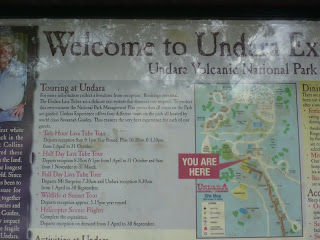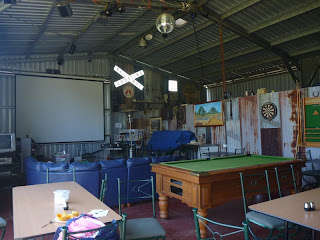 We had stayed overnight at Ravenshoe – this small town is well set up for RV’s and caravans with a great area close to the shops to stay overnight in, with toilets and showers for a gold coin donation and just a short drive to a dump point and water. Lots of other towns could follow Ravenshoe’s example. The town is rewarded with visitors staying and spending in their businesses. The historic railway is a feature of the town and it was just a shame we couldn’t go for a ride on the train.
We had stayed overnight at Ravenshoe – this small town is well set up for RV’s and caravans with a great area close to the shops to stay overnight in, with toilets and showers for a gold coin donation and just a short drive to a dump point and water. Lots of other towns could follow Ravenshoe’s example. The town is rewarded with visitors staying and spending in their businesses. The historic railway is a feature of the town and it was just a shame we couldn’t go for a ride on the train.
 |
| Ravenshoe Station |
The next stop was at Innot Springs. We didn’t see a soul at either the camping ground or the hotel so couldn’t find out much about the springs. We had been told that the best way to experience the springs was to wander the river bed and locate the hot springs. This was not difficult to do – the creek had many hot spots. It reminded us much of Hot Water Springs beach in New Zealand.
We continued on the Savannah Way towards Mt Surprise and detoured to the Undara Lava Tubes – these are a series of caves that have formed from volcano eruptions. The afternoon tour took us to two of the caves – Stephens and Arch. Because the last wet season was much wetter than normal there was water in both of these caves which apparently only happens about once in twenty years. The Savannah Guide explained about the formation of the caves. In the Arch cave we followed the board walk which was covered with water to a depth of about knee depth. The lava tube was various colours from white, gold, orange, brown, black and pink. The guide pointed out various designs in the walls which looked like Aboriginal paintings of animals, hearts etc but these were in fact natural markings. Although it was in the high 30’s outside the caves were cool inside even though they were not deep.
We continued on to Mt Surprise and stayed overnight in a camping ground – we were the only campers that night. The camp had a very interesting cafe serving breakfast, coffee etc. We proceeded on the Savannah Way to Georgetown and stopped at the historic Cumberland Mine area for lunch. Continuing on we stopped at Croydon where the lady who served us was from Muritai near Auckland. She was happy to chat to some Kiwi’s as she had lived in Croydon for 30 years – we couldn’t imagine leaving any part of Auckland to live in Croydon which is so small.
We stayed at Leichhardt Lagoon Camping Ground which is a bush camping facility just outside Normanton. We were invited to join happy hour as we booked in and the group were very friendly. We ended up staying two nights instead of the planned one, and joined most of the other campers and went to the Leichhardt Station for a three course dinner for $5 each. The dinner was very basic (soup, rice and a very thin sausage goulash, sticky date pudding and custard) but it was an enjoyable experience and a good chance to socialise with other campers.
Peter had an experience he didn’t like when we were at Leichhardt Lagoon – there are numerous frogs and he went to go to the toilet and he was met with the view of two frogs in the bowl and a few more legs clinging for their life from the lip at the top. He soon decided that he was happy to use the caravan toilet while staying at that camp. I didn’t have the same experience in the women’s toilets so didn’t have to make a decision. It was cute to read the frog poem on the inside of the toilet door though!
As we have travelled in Far North Queensland we have seen numerous road signs advising that the area is subject to flooding with markers indicating the depth. We were told that the camping ground goes under water each year during the wet season and at times the amenities block is completely under water. The station owner said that during the wet season he is able to launch his tinnie direct from his lawn area where we had dinner. The stations are stocked with huge Brahman beasts and we can only assume that these survive the wet or are moved out of the area on the cattle road trains.
We travelled on to Normanton which is again a very small town with very little activity. We visited the information centre which is in the Burns Philp original store – this was interesting for me as I worked with the Burns Philp company over the past few years. From Normanton we drove on to Karumba to complete our trip to the Gulf of Carpentaria – Karumba is the only coastal area accessible by asphalt road and is very popular for fishing. The town is very small with a population of 600 but this swells significantly during the winter months when people come in the hope of catching barramundi and prawns. There are three camping grounds in the town which were still quite busy although we are now late in the season. We had been told that up to 45 caravans a day are now heading out of Karumba. We had an early lunch at one of the seafood cafes and enjoyed a Father’s Day special. The barramundi was certainly good. As neither of us are keen on fishing, and didn’t want to stay 2-3 months like most visitors, we had a good look around before continuing our journey. This meant returning via Normanton and proceeding south towards Cloncurry. On the way we saw three road trains lined up – they were loaded with cattle and soon moved off to commence their journey.
 We had stayed overnight at Ravenshoe – this small town is well set up for RV’s and caravans with a great area close to the shops to stay overnight in, with toilets and showers for a gold coin donation and just a short drive to a dump point and water. Lots of other towns could follow Ravenshoe’s example. The town is rewarded with visitors staying and spending in their businesses. The historic railway is a feature of the town and it was just a shame we couldn’t go for a ride on the train.
We had stayed overnight at Ravenshoe – this small town is well set up for RV’s and caravans with a great area close to the shops to stay overnight in, with toilets and showers for a gold coin donation and just a short drive to a dump point and water. Lots of other towns could follow Ravenshoe’s example. The town is rewarded with visitors staying and spending in their businesses. The historic railway is a feature of the town and it was just a shame we couldn’t go for a ride on the train. 











































































Loved the photos, you are certainly covering some distance! Loved the frog poem, I love frogs but I am not sure about sharing the loo with them! Do they mind if you sit on them?
ReplyDeleteKeep in touch, Julia xx
You know what Pete - it would have been really nice to have seen that old train going :)
ReplyDeleteDave
I have enjoyed reading your articles. It is well written. It looks like you spend a large amount of time and effort in writing the blog. I am appreciating your effort. You can visit my website.
ReplyDeleteBed bugs